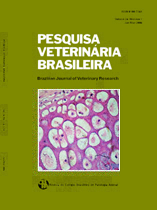 |
|
|
|
Year 2014 - Volume 34, Number 6
|

|
Evaluation of a model for induction of periodontal disease in dogs, 34(6):562-568
|
ABSTRACT.- Sepúlveda R.V., Reis E.C.C., Valente F.L., Brezinski D.G. & Borges A.P.B. 2014. Eva-
luation of a model for induction of periodontal disease in dogs. Pesquisa Veterinária Brasileira 34(6):562-568. Departamento de Veterinária, Universidade Federal de Viçosa, Campus Viçosa, Avenida P.H. Rolfs s/n, Viçosa, MG 36570-000, Brazil. E-mail: andrea@ufv.br
There are several methods for inducing periodontal disease in animal models, being the bone defect one of the most reported. This study aimed to evaluate this model, through clinical, radiographic, tomographic and histological analyzes, thus providing standardized data for future regenerative works. Twelve dogs were subjected to the induction protocol. In a first surgical procedure, a mucoperiosteal flap was made on the buccal aspect of the right third and fourth premolars and a defect was produced exposing the furcation and mesial and distal roots, with dimensions: 5mm coronoapical, 5mm mesiodistal, and 3mm buccolingual. Periodontal ligament and cementum were curetted and the defect was filled with molding polyester, which was removed after 21 days on new surgical procedure. Clinical and radiographic examinations were performed after the two surgeries and before the collection of parts for dental tomography and histological analysis. All animals showed grade II furcation exposure in both teeth. Clinical attachment level increased after induction. Defect size did not change for coronoapical and buccolingual measurements, while mesiodistal size was significantly higher than at the time of defect production. Radiographic analysis showed decreased radiopacity and discontinuity of lamina dura in every tooth in the furcation area. The horizontal progression of the disease was evident in micro-computed tomography and defect content in the histological analysis. Therefore, it is concluded that this method promotes the induction of periodontal disease in dogs in a standardized way, thus being a good model for future work. |
| |
|
|
| |
|
 |